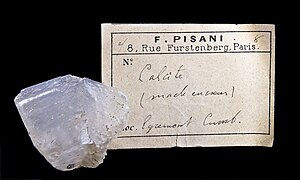Félix Pisani
Félix Pisani (born April 28, 1831 in Constantinople , † November 7, 1920 in Paris ) was a French scientist, chemist , mineralogist and mineral dealer.
Life
Félix Pisani was born on April 28, 1831 in Constantinople as the son of a diplomat from Venice who was active there as a representative of Russia . He was drawn to chemistry at an early age, possibly due to his maternal descent: his grandfather Félix de Serres was a professor of chemistry at the University of Clermont-Ferrand . In 1854, on the recommendation of his grandfather, Félix Pisani was admitted to Charles Frédéric Gerhardt's chemistry school in Paris, where he quickly became one of Gerhardt's favorite students. After Gerhardt was appointed to Strasbourg in 1855, the laboratory was led by Emil Kopp until Pisani finally took over the management of the institute.
At the same time, Pisani opened his first mineral shop in the Rue de l'Ancienne Comédie in Paris, and only a short time later, together with the mineralogist and trader Louis Sæmann and the geologist and botanist Emile Goubert, the trading house Comptoir de géologique et in the Rue de Mézières to found botanique , which he later ran alone. Evidence in the British Museum dates from this period, proving that Pisani sold minerals to the museum from 1869 onwards. He expanded his activities to include paleontology, and in 1891 sold an important collection, annotated by the French paleontologists M. Baron and Maurice Cossmann , to the Martorell Museum in Barcelona .
Pisani eventually moved to Rue de Furstenberg, where he not only lived but also had his laboratory. He gave chemistry lessons and private courses there and traded in geoscientific collectibles there. Over time, his laboratory became the go-to place for many mineralogists. This rush led him to found the Société Minéralogique de France together with other mineralogists in 1878 .
Pisani was a member of the Société Géologique de Belgique . Among other things, the chemist Roberto Duarte Silva (1837–1889) was one of his students.
Pisani as a mineralogist
Pisani's works on the chemistry of minerals date from the period between 1854 and 1915. His most important work was the treatise Traité Élémentaire de Minéralogie from 1875, which was revised and supplemented in 1883. In addition, he wrote numerous other works, including the treatise Traité pratique d'analysis chimique qualitative et quantitative , which was published in 1900 by F. Alcan.
Mineralogy owes numerous mineral descriptions to him, including that of Kalicinite in 1865, which was first described as a new type of mineral Kalicine from Chypis ( Chippis ) in Valais . "Found in the beautiful collection of Mr. Adam , under the designation potassium carbonate." It is a bicarbonate that crystallizes in the orthorhombic system . The mineral pisanite described by Gustav Adolf Kenngott in 1860 was dedicated to him, but it turned out to be a variety of the copper-containing melanterite .
Inscription by Pisani: Calcite - twin surfaces according to [1011], Egremond , Cumberland Inscription by Pisani: Smithsonite , Graphic Mine, New Mexico , USA
Individual evidence
- ^ LJ Spencer (1921): Biographical notices of mineralogists recently deceased; with an index to those previously published in this magazine. Mineralogical Magazine, 19, 240-259.
- ^ Traité Élémentaire de Minéralogie. (Précédé d'une Préface par M. Des Cloizeaux ), Paris, G. Masson, 1875.
- ↑ Traité Élémentaire De Minéralogie; Par MF Pisani Précédé D'Une Préface Par M. Des Cloizeaux, De L'Institut; Deuxième Édition Revue Et Augmentée Avec 192 figures dans le texte; Paris, G. Masson, Editeur; Libraire De L'Académie De Médecine, 120, Boulevard Saint-Germain; MDCCCLXXXIII.
- ↑ Il a trouvé dans la belle collection de M. Adam, sous le nom de carbonate de potasse
- ^ Pisani (1865), Comptes rendus de l'Académie des sciences de Paris, 60, p. 918.
| personal data | |
|---|---|
| SURNAME | Pisani, Felix |
| BRIEF DESCRIPTION | French mineralogist and chemist |
| DATE OF BIRTH | April 28, 1831 |
| PLACE OF BIRTH | Constantinople |
| DATE OF DEATH | November 7, 1920 |
| Place of death | Paris |


